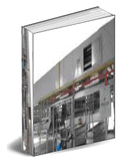Molding of thick rubber products
JohnWoon: No problem! I shall attempt to handle dry rubber problems as well and hope my suggestion would be useful for you.
"Reversion" or over-curing is always a problem with sulphur vulcanization because once the optimized required x-linking density is reached, the reaction does not stop if the rubber is exposed to elevated temperatures. This problem is always evident in the case of thicker articles because rubber is a poor conductor of heat.
In the attempt to ensure the interior of the article receive adequate vulcanization, the exterior or areas near to it could very often be over-cured and you end up with a product that is under performing. I suggest you try the following remedial actions:
1) Preheat the rubber just before moulding but not to the stage of "scorching".
2) Scale down your existing cure temperature at the initial stage of the cure. This is to allow the rubber to get heated up slowly through out its mass without overheating the exterior.
3) Gradually increasing the temperature.
4) Increase level of ZnO if your formulation could take it because ZnO renders better thermal conductivity to the rubber.
5) Use EV system in your cure formulation. If you don’t understand what "EV" is, it is "Efficient Vulcanisation" based on sulphur-donor in the absence of sulphur or at very low level of sulphur. The resultant mono-sulphidic cross-links, as opposed to polysulphidic ones from the conventional cure system, offer better resistance to oxidation especially at elevated temperatures.
I’m expecting a drink from you after your trials. Good luck!
You are at the site for answers and solutions to all your problems in natural rubber latex processing and manufacturing of medical gloves, condoms, catheters, baby teats and baby pacifiers.

















































.jpg)
.jpg)



.jpg)
.jpg)
.jpg)
.jpg)
.jpg)
.jpg)
.jpg)
.jpg)
.jpg)
.jpg)
.jpg)
.jpg)
.jpg)
.jpg)
.jpg)
.jpg)
.jpg)
.jpg)












































